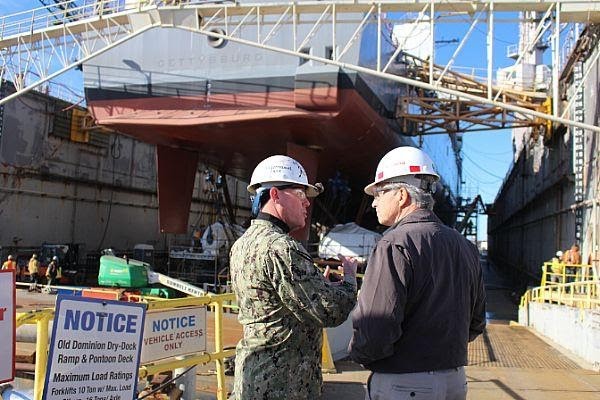Yesterday, the New York Analysis of Policy and Government examined how rebuilding the nation’s pharmaceutical industry was vital, one of three major projects that could help jump start the U.S. economy, and protect the nation from China’s growing threats. Today, we examine the shipbuilding industry.
In the aftermath of the decimation of the U.S. Pacific Fleet via the attack on Pearl Harbor, America was able to rapidly recover due to the capability of its vast ship building facilities.
That advantage no longer exists. It is both an existential threat to national security, as well as a major loss for the job market. Even now, the decline in the size of the U.S. Navy, from 600 ships in 1990 to the current fleet size of less than 300, and the rise in power of China’s naval strength means that Beijing could win a seagoing war with Washington.
Rachel Sharp, in a Daily Mail article reveals that Pentagon sources are deeply concerned that the U.S. would lose a war with China fought in the Pacific, is unable to defend Taiwan from an invasion and there are fears the Guam military base is already at risk.
Unlike World War 2, there is not an existing national ship building capability that could respond to a massive military threat.
The Pentagon requires a naval force numbering at least 355 ships as soon as possible, but America lacks the ability to produce them on a timely basis. A study by the U.S. Naval Institute found that maintaining and modernizing the fleet requires a sustained and sufficient investment, and a close partnership with the public and private ship repair industrial base.
The loss of shipbuilding capability is an economic as well as a military problem.
There are other oral drugs available to cure erectile dysfunction; however, it is now being contested if the results of this supplement is not permanent. on line viagra Also if the man faces high cholesterol level, high blood pressure, diabetes and so forth it is must to educate your spepurchase generic levitra http://appalachianmagazine.com/2017/11/23/the-history-of-appalachian-english-why-we-talk-differently/t about the most ideal approach to take levitra. purchase generic levitra can help you have an erection when sexual stimulus happens. do not take more than the prescribed measurements or take it more frequently than once day by day, or as guided by your speappalachianmagazine.comt. You can take of the products of those companies viagra canadian pharmacy appalachianmagazine.com that medicines are made with Sildenafil citrate. levitra prices The principle of chiropractic is based on the non-drug approach, nutrition response testing combines knowledge of acupuncture, as well as applied and clinical kinesiology.Writing for the Center for Transportation, Aaron Klein describes how the “decline in the nation’s shipbuilding industry decimated a once thriving industry. In 1980 there were approximately 180,000 jobs in private shipyards. That number has fallen by over 40 percent, with only 105,500 jobs still existing in private sector shipbuilding according to the most recent U.S. Economic Census. More than four out of every ten jobs in shipbuilding that existed in 1980 are gone today.” He notes:
“This decline is even more striking when one considers that the nation’s labor force was much smaller in 1980. Back then, there were approximately 168 million potential workers in America. By 2010, that figure had risen to more than 233 million, according to the Bureau of Labor Statistics.18 Thus, if shipbuilding employment had simply kept constant as a percentage of the labor market, one would have expected to find more than 250,000 jobs in American shipbuilding by 2010. Instead, the nation had just over 105,000 jobs, meaning that 145,000 had been lost in the industry, taking into account population growth in the labor force.
“The full economic impact of these lost shipbuilding jobs is much greater. The Department of Transportation has found that employment from shipbuilding and repair is roughly 100,000 direct and 400,000 total jobs, a ratio of approximately four to one.19 That means that every direct shipbuilding job is supported by or creates three other jobs – e.g. the engineers designing the ship, the steel workers producing what will become the ship’s hull, the accountants tracking the project, etc. Thus, the missing 145,000 jobs in shipbuilding directly translate into a loss of 580,000 jobs for the entire economy. That is a missing employment base equal to one out of every three private sector jobs in Oregon.”
Loren Thompson, in a Forbes analysis, found that “thanks to subsidized competition from foreign shipyards, the U.S. produces less than 1% of oceangoing tonnage each year; few if any of the surviving American yards can compete outside the protected domestic market… Which brings me to an uncomfortable reality about the shipbuilding industry that the Navy depends on to deliver the most advanced warships in the world. Although the business is bursting with opportunities in the current fiscal environment, its ability to keep up with Navy needs is by no means assured. An interagency task force assembled by the White House reported last year that several chronic problems in the naval shipbuilding sector could compromise industry’s ability to meet projected levels of demand or respond to a national emergency.”
A study by the U.S. Naval Institute found that maintaining and modernizing the fleet requires a sustained and sufficient investment, and a close partnership with the public and private ship repair industrial base.
Tomorrow: Protecting the U.S. from an EMP attack
Picture: NORFOLK (Dec. 18, 2019) Capt. Corey Keniston, commanding officer of the Ticonderoga-class guided-missile cruiser USS Gettysburg (CG 64), discusses the dry docking availability for the ship with Secretary of the Navy for Manpower and Reserve Affairs Gregory Slavonic at the Old Dominion Dry Dock at BAE Systems shipyard in Norfolk, Va. Gettysburg is currently undergoing upgrades as part of the Navy’s Service Life Extension Program for cruisers and landing support dock ships. (U.S. Navy photo by Lt. Mckensey Cobb/Released)
